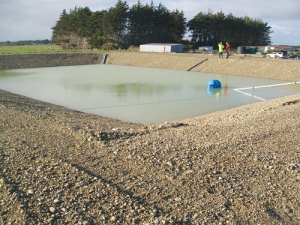Dairy sector profit still on the table, but margin gap tightens
DairyNZ’s latest Econ Tracker update shows most farms will still finish the season in a positive position, although the gap has narrowed compared with early season expectations.
 A site investigation before design and construction is important to ensure the pond built is structurally sound and meets regulations.
A site investigation before design and construction is important to ensure the pond built is structurally sound and meets regulations.
A site investigation before design and construction is important to ensure the pond built is structurally sound and meets regulations, says DairyNZ.
While an engineer will probably do the site investigation, the responsibility for proving the adequacy of a pond and liner rests with the farmer.
The soil type where the effluent pond will be located is also important.
In comparison to most other soil types, peat soils require more ground investigation. The main issues are peat thickness, strength, compressibility and groundwater level.
Before ground investigations begin, a desktop study should be done by your designer, who should then explore the site. There should be a minimum of three holes around the perimeter of the proposed tank or pond. The investigation should extend to the full depth of the peat, or to twice the width of the proposed tank or pond bank.
Your designer should then perform specific engineering tests to determine the suitability of the site and the design requirements.
During the investigation and design stage make sure you discuss with the designer the cost versus benefit of different design options for peat versus the long term maintenance costs of each.
Effluent systems can include a solids separation component. This can be either mechanical (press type systems) or non-mechanical (weeping wall type systems).
If solids are removed prior to the effluent reaching the storage pond, this averts or at least reduces the risks inherent in managing the solids in the pond. But you still must store and manage them. Mechanical removal should usually be done before effluent enters the storage pond.
Non-mechanical separation methods are generally weeping wall or settling pond systems. These fundamentally change the pond design requirements. In this case the pond component of the solids removal system needs to be designed specifically for solids removal.
The National Wild Goat Hunting Competition has removed 33,418 wild goats over the past three years.
New Zealand needs a new healthcare model to address rising rates of obesity in rural communities, with the current system leaving many patients unable to access effective treatment or long-term support, warn GPs.
Southland farmers are being urged to put safety first, following a spike in tip offs about risky handling of wind-damaged trees
Third-generation Ashburton dairy farmers TJ and Mark Stewart are no strangers to adapting and evolving.
When American retail giant Cosco came to audit Open Country Dairy’s new butter plant at the Waharoa site and give the green light to supply their American stores, they allowed themselves a week for the exercise.
Fonterra chair Peter McBride says the divestment of Mainland Group is their last significant asset sale and signals the end of structural changes.
President Donald Trump’s decision to impose tariffs on imports into the US is doing good things for global trade, according…
Seen a giant cheese roll rolling along Southland’s roads?